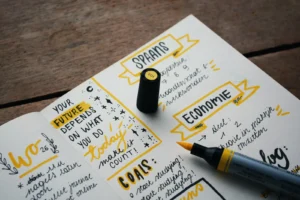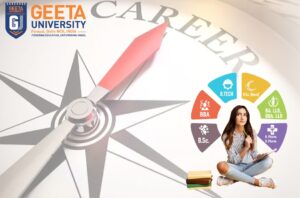Crafting Your Path to Success: A Comprehensive Guide to Building a Fulfilling Career
UncategorizedCrafting Your Path to Success: A Comprehensive Guide to Building a Fulfilling Career
- June 11, 2024
- Geeta University
Introduction:
Embarking on a journey to build a successful and fulfilling career is an exciting endeavor that requires thoughtful planning, continuous learning, and strategic decision-making. In this detailed guide, we will explore the key components that contribute to making a good career, from defining your career goals to honing essential skills and navigating the professional landscape.
1. Self-Reflection and Goal Setting:
Self-reflection and goal setting serve as indispensable compasses guiding individuals on their journey of personal and professional development. In this detailed exploration, we delve into the profound impact of self-reflection and the strategic art of goal setting. Understanding the intricacies of these processes empowers individuals to chart a purposeful course towards their aspirations.
1. The Essence of Self-Reflection:
•Defining Self-Reflection:
•Self-reflection is the intentional examination of one’s thoughts, feelings, and experiences.
•It involves gaining a deeper understanding of oneself and one’s journey.
•Benefits of Self-Reflection:
•Enhanced self-awareness: Recognizing strengths, weaknesses, and values.
•Improved decision-making: Informed choices aligned with personal goals.
•Emotional intelligence: Understanding and managing emotions effectively.
•Methods of Self-Reflection:
•Journaling: Recording thoughts, experiences, and insights in a personal journal.
•Meditation and mindfulness: Cultivating a focused awareness of the present moment.
•Seeking feedback: Soliciting constructive feedback from peers, mentors, or self-assessment tools.
The Transformative Power of Goal Setting:
•Defining Goal Setting:
•Goal setting involves the process of articulating specific, measurable, achievable, relevant, and time-bound (SMART) objectives.
•Goals serve as milestones that direct efforts towards desired outcomes.
•Advantages of Goal Setting:
•Clarity and focus: Clearly defined goals provide a sense of direction.
•Motivation and commitment: Goals inspire action and commitment to achieving results.
•Measurement of progress: Goals facilitate the tracking of achievements and areas for improvement.
•Types of Goals:
•Short-term goals: Attainable objectives within a relatively brief timeframe.
•Long-term goals: Aspirations requiring sustained effort over an extended period.
•Process goals: Focused on the steps and actions necessary for achievement.
Integrating Self-Reflection into Goal Setting:
•Aligning Goals with Values:
•Self-reflection aids in identifying core values and principles.
•Goals grounded in personal values foster a sense of authenticity and fulfillment.
•Assessing Personal Strengths and Weaknesses:
•Understanding strengths maximizes their utilization in goal pursuit.
•Acknowledging weaknesses informs strategies for improvement.
•Examining Motivations and Passions:
•Self-reflection uncovers intrinsic motivations and passions.
•Goals driven by genuine passion elicit sustained commitment and enthusiasm.
Crafting SMART Goals:
•Specific:
•Clearly define the goal, leaving no room for ambiguity.
•Answer the questions: What? Why? How?
•Measurable:
•Establish criteria to quantify progress and success.
•Include concrete metrics or indicators.
•Achievable:
•Ensure the goal is realistic and attainable given available resources.
•Break larger goals into smaller, manageable steps.
•Relevant:
•Align the goal with broader objectives and personal values.
•Assess its significance in the context of your aspirations.
•Time-Bound:
•Set a specific timeframe for goal completion.
•Deadlines provide a sense of urgency and structure.
Creating a Self-Reflective Goal-Setting Framework:
•Define Long-Term Objectives:
•Envision overarching goals that align with your life’s purpose.
•Consider aspirations in various aspects, such as career, personal development, and relationships.
•Break Down into Short-Term Goals:
•Deconstruct long-term goals into smaller, manageable short-term objectives.
•Short-term goals serve as stepping stones toward larger achievements.
•Regularly Review and Adjust:
•Schedule periodic self-reflection sessions to review progress.
•Adjust goals based on evolving priorities, experiences, and insights.
Overcoming Challenges and Cultivating Resilience:
•Embracing Setbacks as Learning Opportunities:
•View obstacles as chances to learn and grow.
•Extract lessons from challenges to refine future goals.
•Staying Flexible and Adaptable:
•The ability to adapt goals in response to changing circumstances is vital.
•Flexibility allows for a more responsive and resilient approach.
•Celebrating Achievements:
•Acknowledge and celebrate successes, no matter how small.
•Positive reinforcement enhances motivation and commitment.
Seeking Support and Accountability:
•Engaging in Collaborative Reflection:
•Share reflections and goals with trusted friends, mentors, or colleagues.
•External perspectives offer valuable insights and encouragement.
•Establishing Accountability Partnerships:
•Pairing up with an accountability partner fosters mutual support.
•Regular check-ins ensure adherence to goals and sustained progress.
2. Continuous Learning and Skill Development:
In a world marked by rapid advancements and evolving landscapes, the commitment to continuous learning and skill development has become more than a personal choice—it’s a professional imperative. This exploration delves into the significance of continuous learning, the symbiotic relationship between knowledge acquisition and skill development, and practical strategies to foster ongoing growth in various facets of life.
The Dynamic Nature of Continuous Learning:
•Defining Continuous Learning:
•Continuous learning is an ongoing, intentional process of acquiring knowledge, skills, and insights throughout one’s life.
•It involves adapting to new information, staying current with industry trends, and embracing a mindset of curiosity.
•Incorporating a Growth Mindset:
•A growth mindset sees challenges as opportunities for growth.
•Embracing the belief that abilities can be developed through dedication and hard work fuels a commitment to continuous learning.
The Interplay Between Learning and Skill Development:
•Understanding the Relationship:
•Learning is the acquisition of knowledge, while skill development is the application of that knowledge in practical situations.
•Continuous learning feeds into skill development, creating a symbiotic relationship.
•Knowledge Transfer to Skill Mastery:
•The process involves moving from theoretical understanding to practical application.
•Application and repetition refine skills, transforming them into competencies.
Practical Strategies for Continuous Learning:
•Formal Education and Training:
•Pursue formal education through degree programs, workshops, or professional certifications.
•Institutions and training programs offer structured learning environments.
•Online Learning Platforms:
•Utilize online platforms offering courses in diverse subjects.
•Platforms like Coursera, Udacity, and LinkedIn Learning provide flexibility and access to a wide range of topics.
•Professional Development Opportunities:
•Attend conferences, seminars, and industry events to stay informed about the latest trends.
•Networking at these events fosters both learning and skill development.
Embracing Informal Learning:
•Reading and Research:
•Cultivate a habit of reading books, articles, and research papers.
•Stay informed about advancements in your field and related disciplines.
•Podcasts and Webinars:
•Engage with educational podcasts and webinars hosted by experts.
•These mediums provide insights, expert interviews, and real-world applications of knowledge.
•Communities of Practice:
•Join online or local communities related to your profession or interests.
•Collaborate with peers, share experiences, and learn from the collective knowledge of the community.
Skill Development Strategies:
•Project-Based Learning:
•Engage in hands-on projects to apply theoretical knowledge.
•Real-world application enhances skill development and problem-solving abilities.
•Mentorship and Apprenticeship:
•Seek mentorship from experienced professionals in your field.
•Apprenticeships provide practical exposure and direct guidance for skill enhancement.
•Cross-Functional Collaboration:
•Collaborate with colleagues from different departments or industries.
•Exposure to diverse perspectives broadens skill sets and fosters innovation.
Reflective Practice:
•Reviewing and Assessing Performance:
•Regularly assess your own performance.
•Identify areas of strength and those requiring improvement for targeted skill development.
•Feedback and Self-Reflection:
•Seek feedback from peers, supervisors, or mentors.
•Combine external insights with self-reflection to refine skills.
Integrating Learning into Daily Routines:
•Microlearning:
•Embrace microlearning by breaking down topics into small, digestible portions.
•Consistent, short learning sessions fit seamlessly into daily routines.
•Utilizing Downtime:
•Leverage downtime for learning, such as during commutes or breaks.
•Podcasts, audiobooks, or mobile learning apps make learning accessible anytime, anywhere.
Setting Personal Learning Goals:
•SMART Learning Goals:
•Establish Specific, Measurable, Achievable, Relevant, and Time-bound (SMART) learning goals.
•Clearly defined objectives provide focus and motivation.
•Long-Term Development Plans:
•Outline long-term plans for continuous learning and skill development.
•Align goals with personal and professional aspirations.
3. Networking and Building Professional Relationships:
: In the interconnected world of careers and opportunities, the art of networking is a powerful catalyst for personal and professional growth. This exploration delves into the intricacies of networking, highlighting its importance, offering strategies for effective relationship-building, and emphasizing the enduring value of meaningful professional connections.
•Cultivating a Network:
•Attend industry events, seminars, and networking sessions to connect with professionals in your field.
•Online platforms like LinkedIn can be powerful tools for expanding your professional network.
•Networking is the intentional process of cultivating relationships to exchange information, advice, and opportunities.
•It extends beyond mere socializing to create a mutually beneficial web of professional connections.
•Mentorship and Guidance:
•Seek mentorship from experienced professionals who can provide guidance and insights.
•Mentorship relationships can offer valuable perspectives and open doors to opportunities.
4. Gaining Practical Experience:
•Internships and Apprenticeships:
•Seek internships or apprenticeships to gain hands-on experience in your chosen field.
•Practical exposure enhances your skill set and makes you more attractive to employers.
•Freelancing and Side Projects:
•Engage in freelancing or side projects to showcase your abilities.
•Building a portfolio demonstrates your practical application of skills.
5. Crafting a Strong Resume and Personal Brand:
•Tailoring Your Resume:
•Customize your resume to highlight relevant skills, experiences, and achievements.
•Use action verbs and quantify accomplishments to make your resume stand out.
•Building a Personal Brand:
•Develop a personal brand that aligns with your professional identity.
•Consistency across online profiles, resumes, and cover letters strengthens your brand.
6. Effective Job Search Strategies:
•Targeted Job Searches:
•Focus on companies and roles aligned with your career goals.
•Utilize job search platforms, company websites, and professional networks.
•Crafting a Compelling Cover Letter:
•Tailor your cover letter to showcase your qualifications and express genuine interest in the position.
•Use the cover letter as an opportunity to narrate your career story.
7. Interview Preparation and Soft Skills:
•Research and Preparation:
•Thoroughly research the company and the role you are interviewing for.
•Prepare answers to common interview questions, emphasizing your skills and experiences.
•Soft Skills Development:
•Cultivate soft skills such as communication, teamwork, and adaptability.
•Employers value a well-rounded skill set that includes both technical and interpersonal abilities.
8. Negotiating Compensation and Benefits:
•Understanding Market Rates:
•Research industry standards for salary and benefits in your region.
•Know your worth and be prepared to negotiate based on your qualifications and the company’s offerings.
•Considering Long-Term Growth:
•Assess not only the immediate compensation but also the potential for career growth and skill development.
•Evaluate the overall benefits package, including health benefits, retirement plans, and professional development opportunities.
9. Embracing Professional Growth:
•Setting Short-Term and Long-Term Goals:
•Continuously reassess your career goals and set new objectives for professional growth.
•Embrace challenges that offer opportunities for learning and advancement.
•Seeking Feedback and Performance Reviews:
•Actively seek feedback from peers, mentors, and supervisors.
•Performance reviews provide valuable insights into areas for improvement and areas of strength.
10. Work-Life Balance and Well-being:
•Prioritizing Well-being:
•Strive for a healthy work-life balance to prevent burnout.
•Prioritize self-care activities, including regular exercise, adequate sleep, and stress management.
•Continuous Reflection:
•Regularly reflect on your career journey and well-being.
•Make adjustments to your goals and strategies based on evolving personal and professional priorities.
Conclusion:
Building a successful career is a dynamic and ongoing process that requires adaptability, resilience, and a proactive approach to professional development. By aligning your goals, continually honing your skills, and fostering meaningful professional relationships, you can navigate the complexities of the professional landscape and construct a career that brings both success and fulfillment. Remember that your career journey is unique, and each step contributes to your growth and achievement. Embrace the opportunities that come your way, stay committed to your aspirations, and enjoy the rewarding journey towards a successful career.

Mr. Ritesh
School of Engineering




